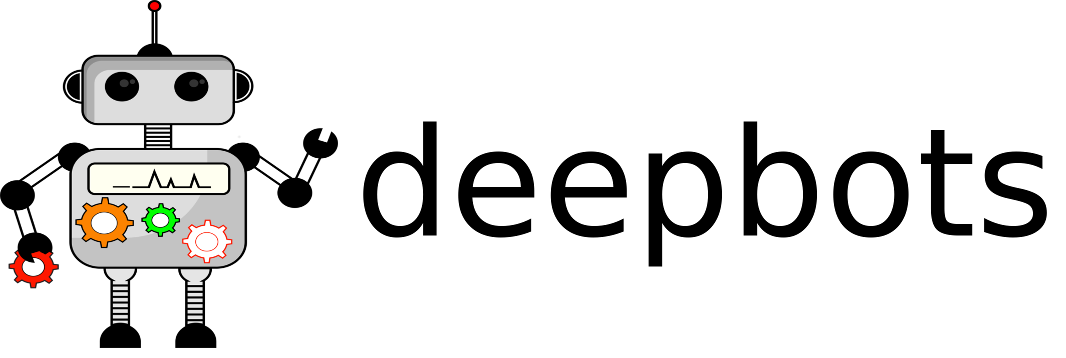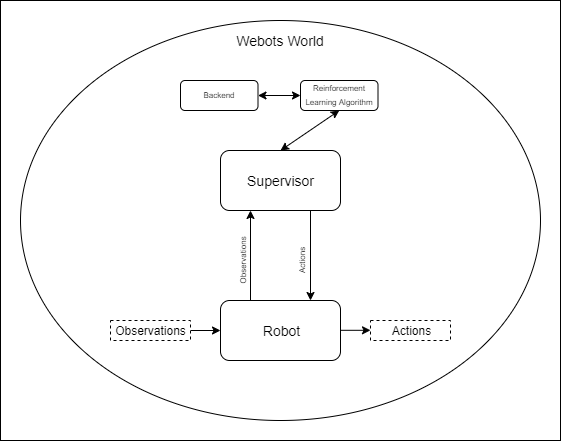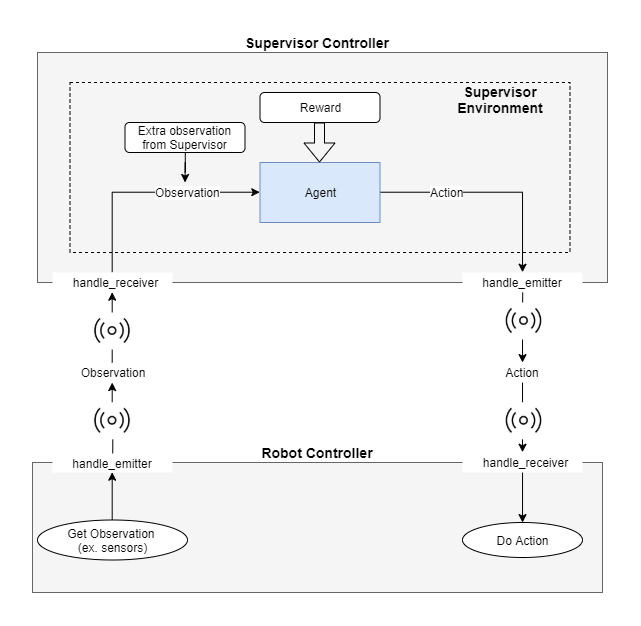Deepbots is a simple framework which is used as "middleware" between the free and open-source Cyberbotics' Webots robot simulator and Reinforcement Learning algorithms. When it comes to Reinforcement Learning the OpenAI gym environment has been established as the most used interface between the actual application and the RL algorithm. Deepbots is a framework which follows the OpenAI gym environment interface logic in order to be used by Webots applications.
- Install Webots
- Install Python version 3.X (please refer to Using Python to select the proper Python version for your system)
- Follow the Using Python guide provided by Webots
- Webots provides a basic code editor, but if you want to use PyCharm as your IDE refer to using PyCharm IDE provided by Webots
You will probably also need a backend library to implement the neural networks, such as PyTorch or TensorFlow. Deepbots interfaces with RL agents using the OpenAI gym logic, so it can work with any backend library you choose to implement the agent with and any agent that already works with gym.
Deepbots can be installed through the package installer pip running the following command:
pip install deepbots
- On the deepbots-tutorials repository you can find the official tutorials for deepbots
- On the deepworlds repository you
can find examples of deepbots being used.
Feel free to contribute your own!
Conference paper (AIAI2020): https://link.springer.com/chapter/10.1007/978-3-030-49186-4_6
@InProceedings{10.1007/978-3-030-49186-4_6,
author="Kirtas, M.
and Tsampazis, K.
and Passalis, N.
and Tefas, A.",
title="Deepbots: A Webots-Based Deep Reinforcement Learning Framework for Robotics",
booktitle="Artificial Intelligence Applications and Innovations",
year="2020",
publisher="Springer International Publishing",
address="Cham",
pages="64--75",
isbn="978-3-030-49186-4"
}
First of all let's set up a simple glossary:
-
World: Webots uses a tree structure to represent the different entities in the scene. The World is the root entity which contains all the entities/nodes. For example, the world contains the Supervisor and Robot entities as well as other objects which might be included in the scene. -
Supervisor: The Supervisor is an entity which has access to all other entities of the world, while having no physical presence in it. For example, the Supervisor knows the exact position of all the entities of the world and can manipulate them. Additionally, the Supervisor has the Supervisor Controller as one of its child nodes. -
Supervisor Controller: The Supervisor Controller is a python script which is responsible for the Supervisor. For example, in the Supervisor Controller script the distance between two entities in the world can be calculated. -
Robot: The Robot is an entity that represents a robot in the world. It might have sensors and other active components, like motors, etc. as child entities. Also, one of its children is the Robot Controller. For example, epuck and TIAGo are robots. -
Robot Controller: The Robot Controller is a python script which is responsible for the Robot's movement and sensors. With the Robot Controller it is possible to observe the world and act accordingly. -
Environment: The Environment is the interface as described by the OpenAI gym. The Environment interface has the following methods:-
get_observations(): Return the observations of the robot. For example, metrics from sensors, a camera image etc. -
step(action): Each timestep, the agent chooses an action, and the environment returns the observation, the reward and the state of the problem (done or not).
-
get_reward(action): The reward the agent receives as a result of their action. -
is_done(): Whether it’s time to reset the environment. Most (but not all) tasks are divided up into well-defined episodes, and done being True indicates the episode has terminated. For example, if a robot has the task to reach a goal, then the done condition might happen when the robot "touches" the goal. -
reset(): Used to reset the world to the initial state.
-
In order to set up a task in Deepbots it is necessary to understand the
intention of the OpenAI gym environment. According to the OpenAI gym
documentation, the framework follows the classic “agent-environment loop”.
"Each timestep, the agent chooses an action, and the environment returns an
observation and a reward. The process gets started by calling reset(),
which returns an initial observation."
Deepbots follows this exact agent-environment loop with the only difference
being that the agent, which is responsible to choose an action, runs on the
Supervisor and the observations are acquired by the robot. The goal of the
deepbots framework is to hide this communication from the user, especially from
those who are familiar with the OpenAI gym environment. More specifically,
SupervisorEnv is the interface which is used by the Reinforcement Learning
algorithms and follows the OpenAI Gym environment logic. The Deepbots framework
provides different levels of abstraction according to the user's needs.
Moreover, a goal of the framework is to provide different wrappers for a wide
range of robots.
Deepbots also provides a default implementation of the reset() method,
leveraging Webots' built-in simulation reset functions, removing the need for
the user to implement reset procedures for simpler use-cases. It is always
possible to override this method and implement any custom reset procedure, as
needed.
Currently, the communication between the Supervisor and the Robot is
achieved via an emitter and a receiver. Separating the Supervisor from
the Robot, deepbots can fit a variety of use-cases, e.g. multiple Robots
collecting experience and a Supervisor controlling them with a single agent.
The way Webots implements emitter/receiver communication requires messages
to be packed and unpacked, which introduces an overhead that becomes
prohibiting in use-cases where the observations are high-dimensional or long,
such as camera images. Deepbots provides another partially abstract class that
combines the Supervisor and the Robot into one controller and circumvents
that issue, while being less flexible, which is discussed
later.
On one hand, the emitter is an entity which is provided by Webots, that
broadcasts messages to the world. On the other hand, the receiver is an
entity that is used to receive messages from the World. Consequently, the
agent-environment loop is transformed accordingly. Firstly, the Robot uses
its sensors to retrieve the observation from the World and in turn uses the
emitter component to broadcast this observation. Secondly, the Supervisor
receives the observation via the receiver component and in turn, the agent
uses it to choose an action. It should be noted that the observation the agent
uses might be extended from the Supervisor. For example, a model might use
LiDAR sensors installed on the Robot, but also the Euclidean distance between
the Robot and an object. As it is expected, the Robot does not know the
Euclidean distance, only the Supervisor can calculate it, because it has
access to all entities in the World.
You can follow the emitter-receiver scheme tutorial to get started and work your way up from there.
As mentioned earlier, in use-cases where the observation transmitted between
the Robot and the Supervisor is high-dimensional or long, e.g. high
resolution images taken from a camera, a significant overhead is introduced.
This is circumvented by inheriting and implementing the partially abstract
RobotSupervisor that combines the Robot controller and the
Supervisor Controller into one, forgoing all emitter/receiver
communication. This new controller runs on the Robot, but requires
Supervisor privileges and is limited to one Robot, one Supervisor.
You can follow the robot-supervisor scheme tutorial to get started and work your way up from there. We recommended this tutorial to get started with deepbots.
The deepbots framework has been created mostly for educational purposes. The
aim of the framework is to enable people to use Reinforcement Learning in
Webots. More specifically, we can consider deepbots as a wrapper of Webots
exposing an OpenAI gym style interface. For this reason there are multiple
levels of abstraction. For example, a user can choose if they want to use CSV
emitter/receiver or if they want to make an implementation from scratch. In
the top level of the abstraction hierarchy is the SupervisorEnv which is the
OpenAI gym interface. Below that level there are partially implemented classes
with common functionality. These implementations aim to hide the communication
between the Supervisor and the Robot, as described in the two different
schemes ealier. Similarly, in the emitter/receiver scheme the Robot also
has different abstraction levels. According to their needs, users can choose
either to process the messages received from the Supervisor themselves or use
the existing implementations.
This project has received funding from the European Union's Horizon 2020 research and innovation programme under grant agreement No 871449 (OpenDR). This publication reflects the authors’ views only. The European Commission is not responsible for any use that may be made of the information it contains.
Thanks goes to these wonderful people (emoji key):
Manos Kirtas 💻 |
Kostas Tsampazis 💻 |
Jiun Kai Yang 💻 |
MentalGear 🤔 |
Dreamtale 🐛 |
Nikolaos Kokkinis-Ntrenis 💻 📖 🤔 |
This project follows the all-contributors specification. Contributions of any kind welcome!
Special thanks to Papanikolaou Evangelia for designing project's logo!








